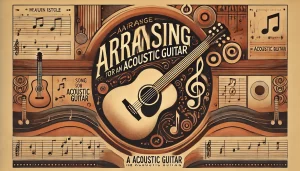Arranging a Song for an Acoustic Guitar
Arranging a song for an acoustic guitar involves several steps, including choosing a chord progression, structuring the piece, and adding embellishments. Here’s a comprehensive guide to get you started:
1. Understanding the Melody
Before you start arranging, you need to understand the melody. Identify the key and the scale of the song, and note any changes in the melody. This will help you choose the appropriate chords and structure the arrangement.
2. Choosing a Chord Progression
Basic Chord Progressions
Start with some basic chord progressions that are commonly used in popular music:
- I-IV-V (1-4-5): Common in many genres (e.g., C-F-G in the key of C major).
- I-V-vi-IV (1-5-6-4): Widely used in pop music (e.g., C-G-Am-F in the key of C major).
- ii-V-I (2-5-1): Often found in jazz and some pop music (e.g., Dm-G-C in the key of C major).
Matching Chords to the Melody
Match the chords to the melody notes:
- Identify which notes in the melody are the strongest (usually the ones on the beat).
- Choose chords that contain these melody notes. For instance, if the melody note is C, suitable chords in the key of C major could be C, Am, F, or Dm.
3. Structuring the Arrangement
Introduction
- Start with a simple intro. This could be a stripped-down version of the chorus or a unique riff that sets the tone.
Verse
- The verse often uses a simpler chord progression to support the melody and lyrics.
Chorus
- The chorus typically has a more powerful progression, creating a climax in the song.
Bridge
- The bridge provides contrast, often with a different progression or key change.
Outro
- The outro can mirror the intro, provide a variation on the chorus, or wind down gradually.
4. Adding Embellishments
Rhythm
- Decide on a strumming pattern or fingerpicking style that fits the mood of the song. Common patterns include down-up strumming, alternating bass notes, or arpeggios.
Dynamics
- Vary the dynamics throughout the song to create interest. Play softer during the verses and louder in the chorus.
Fills and Riffs
- Add small melodic fills or riffs between vocal lines or chord changes.
5. Examples and Practice
Example Song Structure
- Intro: 4 bars (I-IV)
- Verse 1: 8 bars (I-V-vi-IV)
- Chorus: 8 bars (I-IV-V-I)
- Verse 2: 8 bars (I-V-vi-IV)
- Chorus: 8 bars (I-IV-V-I)
- Bridge: 8 bars (vi-IV-I-V)
- Chorus: 8 bars (I-IV-V-I)
- Outro: 4 bars (I-IV)
Practice
- Take a simple melody and apply different chord progressions. Experiment with varying rhythms and dynamics to see what fits best.
Example Arrangement
Let’s say your melody is in the key of C major. Here’s a simple arrangement:
- Intro: C – F – C – G (strumming pattern: down-down-up-up-down)
- Verse: C – G – Am – F (fingerpicking)
- Chorus: C – F – G – C (strumming with emphasis on the downbeat)
- Bridge: Am – F – C – G (use a softer strumming pattern to create contrast)
- Outro: C – F – C – G (slow down the tempo for a gentle finish)
Conclusion
Arranging a song for acoustic guitar involves understanding the melody, choosing the right chords, structuring the song, and adding dynamics and embellishments. Practice with different songs and styles to develop your arranging skills. With time and experimentation, you’ll find what works best for your arrangements.

